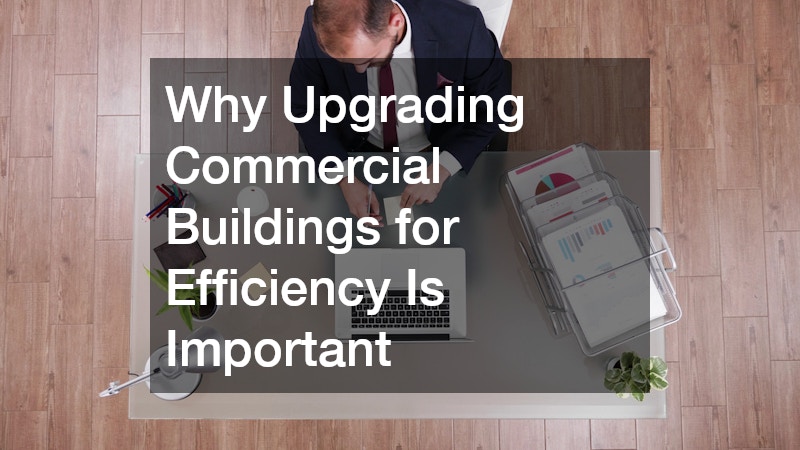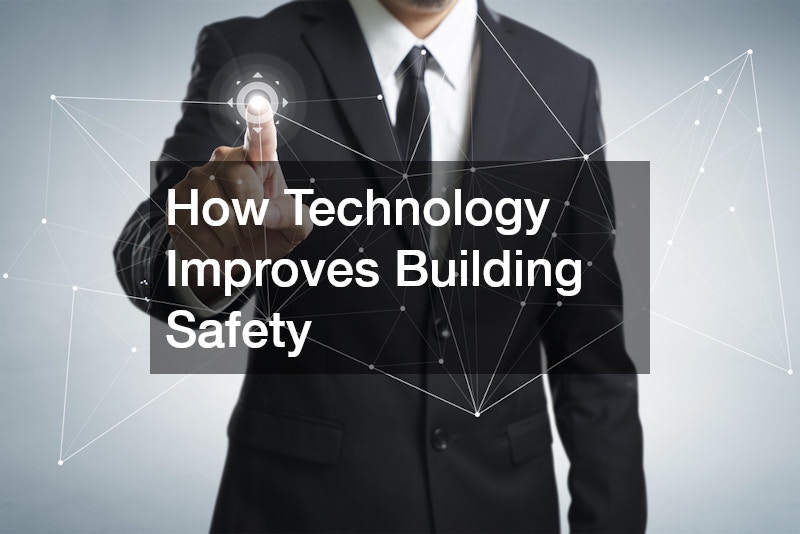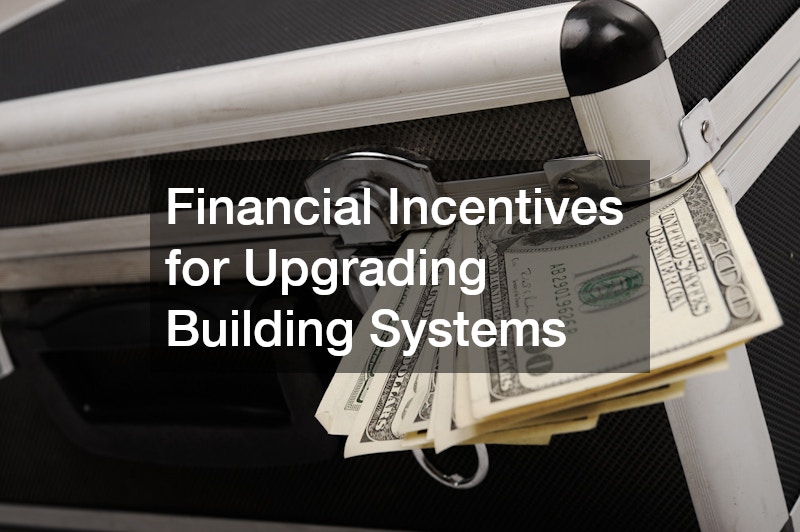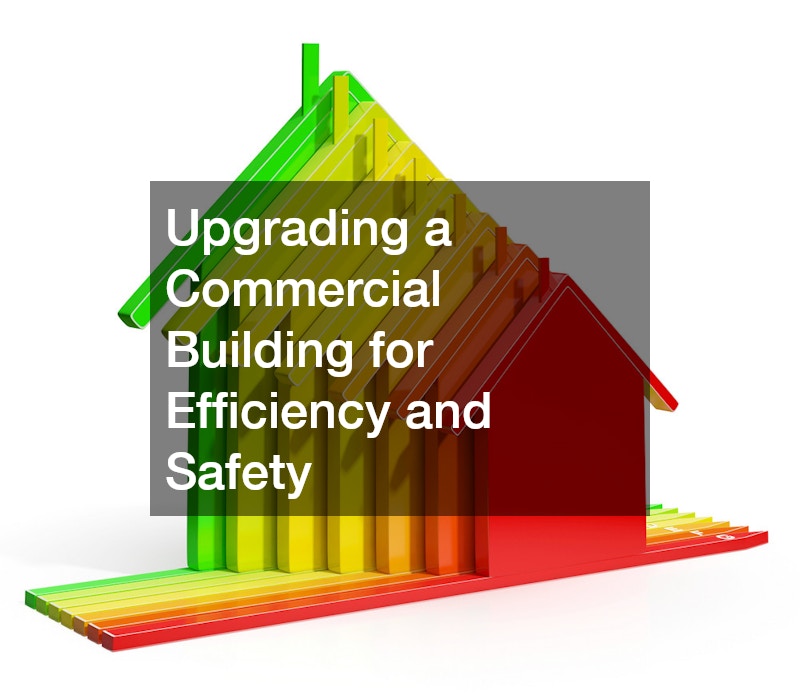In today’s fast-paced business environment, efficiency and safety are critical for the long-term success of any commercial property. Building owners face growing pressures to reduce operational costs, comply with regulations, and create spaces that attract high-quality tenants. Upgrading a commercial building involves strategic improvements to energy systems, safety measures, and structural components. From energy-efficient insulation to smart technology integration, these upgrades can dramatically improve performance while supporting sustainability goals. This article explores the essential aspects of modernizing commercial buildings and the benefits of comprehensive improvements.
Why Upgrading Commercial Buildings for Efficiency Is Important

Energy Cost Savings
Energy costs can account for a significant portion of a commercial building’s operating expenses. Upgrading insulation with high-performance commercial insulation materials, installing energy-efficient commercial floor coatings, and employing the expertise of a commercial hvac contractor or local hvac company can dramatically reduce energy consumption. Even minor improvements, such as retrofitting lighting or optimizing heating and cooling schedules, contribute to measurable reductions in utility bills. Over time, these savings often outweigh the initial investment, making efficiency upgrades a financially sound decision.
Environmental Impact Reduction
Modernizing building systems also helps reduce environmental impact. Energy-efficient HVAC units, improved insulation, and the use of environmentally friendly materials like commercial floor coatings help minimize greenhouse gas emissions. Installing solar-ready roofing or pairing upgrades with a commercial roofing contractor ensures the building is prepared for renewable energy integration. These measures not only support global sustainability goals but also attract tenants and investors who prioritize eco-friendly operations. Corporate social responsibility is increasingly tied to environmental stewardship, making green upgrades essential for long-term reputational and financial success.
Enhanced Comfort and Productivity
A well-maintained and upgraded commercial building contributes to occupant comfort and productivity. Advanced heating, ventilation, and cooling systems installed by a commercial hvac contractor or local hvac company maintain optimal indoor temperatures and air quality. Local water conditioning system upgrades ensure clean water throughout the building, reducing health risks and enhancing comfort. Combined with thoughtful lighting solutions, acoustics, and energy-efficient materials, these improvements create an environment where employees can thrive. Comfortable spaces reduce absenteeism, improve focus, and encourage tenant satisfaction, making productivity gains one of the most valuable outcomes of building upgrades.
Regulatory Compliance and Incentives
Regulations regarding energy efficiency, fire safety, and accessibility continue to evolve. Upgrades such as fire door drop testing, high-quality storefront glass, and compliant commercial insulation ensure that buildings meet these requirements. In many regions, government programs, tax incentives, and utility rebates are available for energy-efficient upgrades, including HVAC system improvements or generator installations. Partnering with a knowledgeable commercial roofing contractor or commercial hvac contractor can help navigate these regulatory frameworks efficiently, ensuring compliance while maximizing financial incentives.
Increased Property Value
Commercial properties that demonstrate efficiency, safety, and modern amenities naturally attract higher valuations. Tenants are willing to pay premium lease rates for buildings that offer reduced operational costs, enhanced comfort, and reliable safety systems. Integrating smart technologies, high-quality storefront glass, or upgraded commercial floor coatings can significantly enhance the appeal of a property. Well-maintained HVAC systems, local generators for backup power, and reliable plumbing infrastructure further strengthen the building’s marketability. These upgrades not only improve resale potential but also provide a competitive advantage in leasing markets.
Key Components of a Successful Building Upgrade
Energy Efficiency Audits
A comprehensive energy efficiency audit identifies opportunities to improve a building’s performance. Professional auditors assess HVAC systems, lighting, insulation, and overall energy consumption. Recommendations often include upgrading commercial insulation, installing energy-efficient lighting controls, and improving water systems with a local water conditioning system. Conducting audits in partnership with a commercial hvac contractor ensures that mechanical systems are optimized and energy savings are maximized.
Safety and Compliance Changes
Safety upgrades are essential for protecting occupants and meeting legal standards. Fire door drop testing, advanced smoke detection, and emergency exit enhancements help ensure compliance with fire safety codes. Structural improvements such as high-performance storefront glass not only improve aesthetics but also strengthen building security. Regular maintenance by certified plumbers, local hvac companies, and commercial roofing contractors ensures that plumbing, electrical, and roof systems function reliably, reducing risk and enhancing safety for all occupants.
HVAC System Upgrades
Efficient HVAC systems are central to a building’s energy performance. Installing high-efficiency heating and cooling units, incorporating zoning systems, and implementing demand-controlled ventilation help minimize energy use while maintaining comfort. Collaborating with a commercial hvac contractor or local hvac company ensures that installations meet performance standards and comply with local regulations. Routine maintenance, combined with advanced thermostat solutions, improves system longevity and reliability, reducing costly emergency repairs.
Lighting Retrofitting
Lighting plays a critical role in both energy efficiency and occupant well-being. Replacing outdated fixtures with energy-saving LED systems and incorporating automated lighting controls allows buildings to reduce electricity consumption without compromising comfort. Daylighting solutions, which maximize natural light, complement artificial lighting and improve productivity. Commercial floor coatings that reflect light effectively can enhance interior brightness while reducing the need for excessive artificial illumination. Innovations such as lighting as a service (LaaS) provide flexible upgrade options without large upfront costs.
Smart Building Technologies
Integrating smart building technologies transforms a standard facility into an intelligent, responsive environment. Building automation systems (BAS) allow centralized control over lighting, HVAC, security, and water systems. IoT sensors monitor energy use, detect anomalies, and facilitate predictive maintenance, helping reduce operational costs. Smart platforms can also track safety compliance, support fire door drop testing schedules, and optimize emergency response. These systems improve operational efficiency while enhancing user experience and ensuring safety standards are consistently met.
How Technology Improves Building Safety

Advanced Surveillance Systems
Modern surveillance systems enhance security across commercial properties. High-resolution cameras, remote monitoring, and integrated access controls help prevent unauthorized entry and quickly respond to incidents. Combining security technology with high-quality storefront glass ensures that entrances are both aesthetically pleasing and secure. Surveillance systems reduce liability while creating safer environments for employees and visitors.
Fire Detection and Suppression Systems
Upgrading fire safety measures is critical for compliance and protection. Fire door drop testing, smoke detection, and sprinkler system enhancements are essential components of a comprehensive safety strategy. These systems, when integrated with a smart building platform, provide real-time alerts and automated responses during emergencies, minimizing potential damage and protecting lives.
Access Control Systems
Modern access control technologies allow precise monitoring of building entry points. Electronic key cards, biometric scanners, and smart locks restrict access to authorized personnel, enhancing both security and operational efficiency. When paired with local generators for emergency power, these systems remain functional during outages, ensuring continuous safety and access control.
IoT for Safety Monitoring
Internet of Things (IoT) sensors enable continuous monitoring of critical building systems. Sensors can track HVAC performance, water quality via a local water conditioning system, and detect leaks or temperature anomalies in plumbing networks. IoT-based monitoring allows for predictive maintenance, reducing system failures and improving overall safety for occupants.
Emergency Response Systems
Automated emergency response solutions, integrated with smart building technology, streamline evacuations and alert authorities during critical events. Features such as fire door drop testing notifications, real-time video monitoring, and centralized alarm management ensure that building occupants receive immediate guidance and that emergency personnel can respond effectively.
The Role of Lighting in Building Efficiency
LED Lighting Benefits
LED lighting provides significant energy savings while improving visual comfort. LEDs use less electricity than traditional lighting and have longer lifespans, reducing maintenance costs. Their compatibility with automated controls makes them ideal for commercial spaces where energy management is a priority. When combined with reflective commercial floor coatings, LED systems can enhance illumination and reduce the need for additional fixtures.
Automated Lighting Controls
Smart lighting controls allow facility managers to adjust lighting schedules based on occupancy and natural light availability. Automated dimming, motion sensors, and programmable schedules ensure that energy is used efficiently without compromising comfort. Integration with building automation systems enhances overall building performance and reduces operational costs.
Daylighting Solutions
Maximizing the use of natural light improves energy efficiency and occupant well-being. Strategically placed windows, skylights, and high-performance storefront glass allow daylight to penetrate deep into the building, reducing reliance on artificial lighting. Daylighting improves mood, supports productivity, and complements energy-saving strategies throughout the building.
Lighting as a Service
Lighting as a Service (LaaS) offers a cost-effective model for commercial upgrades. Rather than paying large upfront costs, building owners subscribe to managed lighting services that include installation, maintenance, and performance monitoring. This approach allows commercial properties to implement state-of-the-art lighting solutions without significant capital expenditure.
Impact on Occupant Well-being
Proper lighting impacts both productivity and health. Bright, evenly distributed light reduces eye strain and fatigue, creating a comfortable workspace. Efficient lighting systems, paired with high-quality commercial insulation and HVAC upgrades, help maintain consistent temperatures and air quality, further improving occupant satisfaction.
Optimizing HVAC Systems for Greater Efficiency
Demand-Controlled Ventilation
Demand-controlled ventilation adjusts airflow based on occupancy levels, reducing energy use while maintaining comfort. Integrating this technology with a commercial hvac contractor or local hvac company ensures proper calibration and compliance with building codes. Reduced energy consumption lowers costs and enhances environmental performance.
High-Efficiency Heating and Cooling Units
Upgrading to high-efficiency HVAC units improves overall system performance. Modern systems use less energy, deliver consistent temperature control, and require less maintenance. Partnering with a commercial hvac contractor ensures that systems are properly sized and installed, maximizing energy savings and occupant comfort.
Regular Maintenance and Servicing
Routine maintenance by qualified professionals, including plumbers, HVAC technicians, and commercial roofing contractors, is essential for long-term system efficiency. Preventative servicing helps identify potential issues early, ensuring continuous operation and reducing costly emergency repairs.
Advanced Thermostat Solutions
Smart thermostats provide precise temperature control and enable energy-saving schedules. These devices can be integrated into building automation systems for centralized control, allowing facility managers to monitor and adjust conditions remotely. Optimized thermostats contribute to reduced energy bills and improved occupant comfort.
Zoning Systems Implementation
Zoning systems divide the building into separate areas with independent temperature controls. This approach improves comfort, reduces energy waste, and allows building managers to respond to different usage patterns. Zoning can be especially beneficial in multi-tenant commercial buildings or areas with variable occupancy.
Financial Incentives for Upgrading Building Systems

Government Tax Credits
Many governments offer tax credits to encourage energy-efficient upgrades. Installing commercial insulation, high-efficiency HVAC systems, or LED lighting may qualify for these programs, reducing the effective cost of improvements. Engaging with a commercial hvac contractor or energy consultant ensures projects meet eligibility requirements.
Utility Company Rebates
Utility companies often provide rebates for installing energy-saving technologies. These incentives can apply to HVAC upgrades, lighting retrofits, and even local water conditioning system improvements. Rebates reduce upfront costs and accelerate return on investment.
Financing Programs
Financing programs allow building owners to spread the cost of upgrades over time, making comprehensive improvements more accessible. Options may include low-interest loans, leasing arrangements, or performance-based financing that links repayment to achieved energy savings.
Grants for Energy Efficiency
In addition to tax credits and rebates, grants are available for commercial properties pursuing sustainability goals. Grants may support projects such as HVAC modernization, energy-efficient roofing installed by a commercial roofing contractor, or renewable energy integration.
Return on Investment Analysis
Careful ROI analysis helps building owners prioritize upgrades based on financial and operational impact. Comparing projected energy savings, maintenance cost reductions, and improved tenant retention against initial investment ensures informed decision-making. Strategic upgrades, such as installing local generators or high-quality storefront glass, offer both financial and functional benefits.
Impact of Building Upgrades on Property Value
Market Demand for Efficient Buildings
Commercial tenants increasingly prefer spaces with energy-efficient systems and modern amenities. Upgraded HVAC units, efficient lighting, commercial floor coatings, and smart building technologies make properties more attractive in competitive markets.
Long-Term Value Retention
Investments in infrastructure, including commercial insulation, fire door drop testing, and plumbing systems, help maintain and even enhance property value over time. Well-maintained buildings remain competitive and resilient against market fluctuations.
Tenant Attraction and Retention
Upgrades that improve comfort, safety, and aesthetics contribute to tenant satisfaction. High-quality storefront glass, efficient HVAC systems, and modern flooring materials signal a commitment to quality and long-term investment, helping retain tenants and reduce vacancy rates.
Appraisal and Re-sale Value
Commercial appraisers recognize the value of energy-efficient, safe, and technologically advanced buildings. Properties with modern HVAC systems, commercial floor coatings, and reliable backup power from local generators often appraise higher, improving re-sale opportunities.
Competitive Advantage in Leasing
Enhanced safety, comfort, and efficiency differentiate properties in crowded markets. A building with robust fire safety measures, commercial insulation, and energy-efficient systems installed by a commercial hvac contractor or local hvac company offers a clear advantage over older, less efficient competitors.
Challenges Associated With Building Upgrades
Initial Cost Expenditures
Comprehensive upgrades, including new HVAC systems, commercial insulation, and local water conditioning systems, require significant upfront investment. Budgeting carefully and leveraging incentives, rebates, and financing programs can alleviate financial strain.
Disruption to Business Operations
Upgrades often require temporary disruptions, particularly when installing commercial floor coatings, HVAC systems, or plumbing infrastructure. Planning construction schedules strategically and coordinating with tenants minimizes operational impact.
Finding Skilled Contractors
Selecting experienced professionals, such as commercial roofing contractors, commercial hvac contractors, plumbers, and specialists for fire door drop testing, ensures that upgrades meet quality and compliance standards. Poor workmanship can compromise efficiency and safety.
Navigating Regulatory Changes
Upgrading buildings requires adherence to evolving codes and standards. Compliance with energy efficiency regulations, fire safety requirements, and accessibility standards demands careful planning and coordination with local authorities.
Ensuring Compatibility With Existing Systems
Integrating new technologies, like local generators, smart HVAC controls, or energy-efficient lighting, with existing infrastructure can be complex. Skilled contractors assess compatibility to avoid costly retrofits or operational disruptions.
Role of Smart Building Technologies in Upgrades
Building Automation Systems
Building automation systems (BAS) allow centralized control over lighting, HVAC, and safety systems. BAS integration enhances efficiency, reduces energy costs, and improves occupant comfort by synchronizing building operations in real time.
IoT Sensors and Applications
IoT sensors monitor air quality, temperature, water quality via a local water conditioning system, and energy consumption. These sensors detect issues before they escalate, enabling predictive maintenance and improved operational safety.
Predictive Maintenance Tools
Predictive maintenance software uses data collected from HVAC systems, generators, and plumbing to forecast potential failures. Timely interventions reduce downtime, extend system lifespans, and maintain efficiency.
Energy Management Platforms
Advanced energy management platforms optimize consumption across all systems, including commercial HVAC units, lighting, and water systems. These platforms provide actionable insights that guide upgrades and ongoing operational improvements.
User Experience Enhancements
Smart building technologies enhance tenant experience by providing personalized climate control, real-time building performance data, and improved safety measures. Integrating these solutions fosters satisfaction, retention, and long-term lease stability.
Upgrading Buildings to Support Sustainability Goals

Reducing Carbon Footprint
Efficiency-focused upgrades, such as high-performance commercial insulation, LED lighting, and energy-efficient HVAC units, help lower greenhouse gas emissions. Reduced carbon footprints demonstrate corporate responsibility and support global sustainability initiatives.
Enhancing Resource Efficiency
Optimized water systems, local water conditioning system upgrades, and energy management platforms improve resource utilization. Reducing waste contributes to cost savings while aligning with environmental standards and green building certifications.
Supporting Green Building Certifications
Modern upgrades, including commercial floor coatings, energy-efficient HVAC systems, and smart building integration, may qualify buildings for certifications like LEED or Energy Star. Certification enhances property value and appeal to tenants seeking sustainable spaces.
Integrating Renewable Energy Sources
Solar-ready roofing, local generators, and energy-efficient infrastructure create opportunities to incorporate renewable energy. These integrations reduce reliance on traditional energy sources and provide resilience during power disruptions.
Promoting Corporate Social Responsibility
Sustainable, safe, and efficient buildings signal a commitment to corporate social responsibility (CSR). Companies that prioritize occupant safety, comfort, and environmental impact foster stronger community and stakeholder relations.
Closing Thoughts
Upgrading a commercial building for efficiency and safety is a strategic investment with lasting benefits. From advanced HVAC systems and commercial insulation to fire door drop testing, high-quality storefront glass, and smart building technologies, these improvements reduce costs, enhance safety, and improve occupant satisfaction. Partnering with experienced professionals, including commercial roofing contractors, local hvac companies, plumbers, and other specialists, ensures that upgrades meet regulatory standards and provide measurable returns. By addressing energy efficiency, safety, and sustainability, building owners can create properties that are resilient, competitive, and valuable for years to come.
